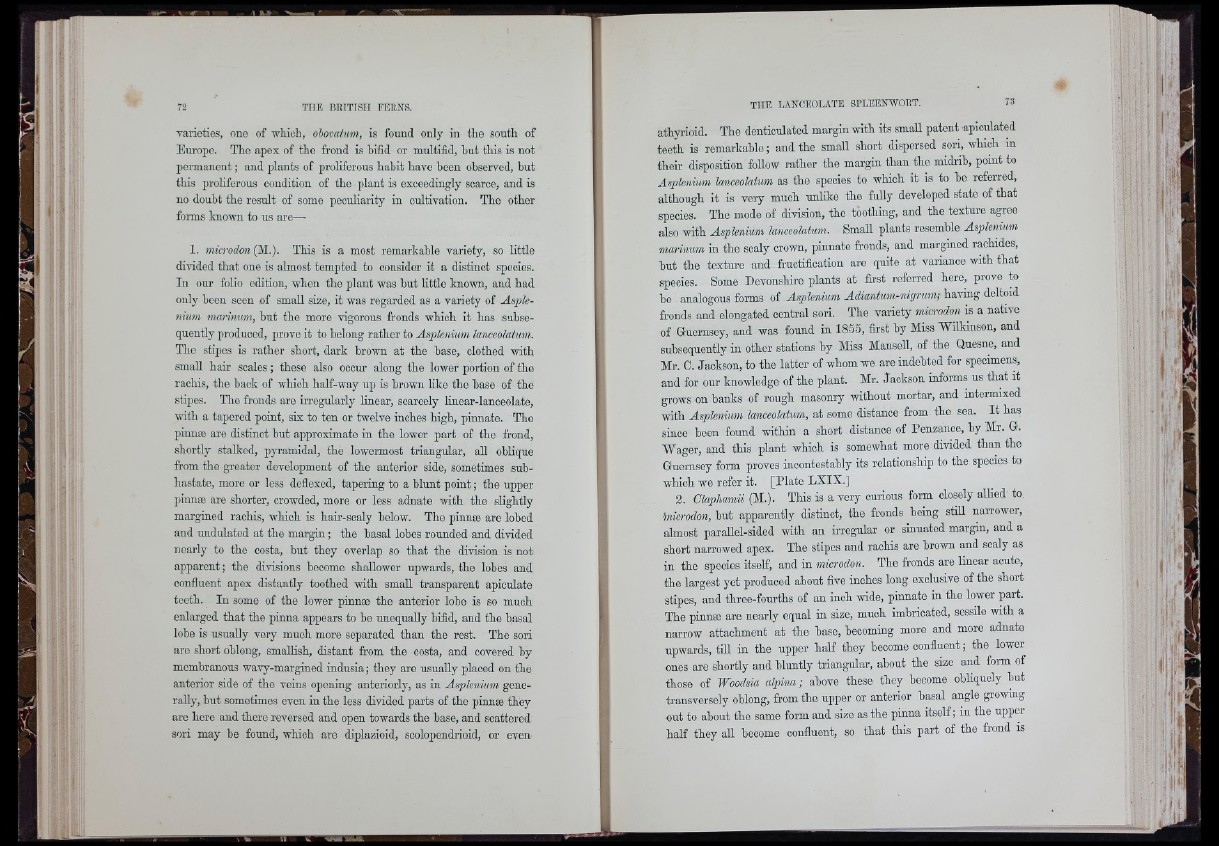
n :
; r
varieties, one of which, ohocatum, is found only in tho south of
Europe. Tho apex of the frond is bifid or multifid, but this is not
permanent ; and plants of proliferous habit bavo been observed, but
this proliferous condition of tho plant is exceedingly scarce, and is
no doubt tho result of some peculiarity in cultivation. Tbe other
forms known to us are—
1. microdon (M.). Tbis is a most remarkable variety, so little
divided that one is almost tempted to consider it a distinct species.
In oui- folio edition, when tbo plant was but little known, and bad
only been seen of small size, it was regarded as a variety of Asplenium
marinum, but the more vigorous fronds wbiob it has subsequently
produced, prove it to belong ratber to Asplenium lanceolatum.
Tbe stipes is ratber short, dark brown at the base, clothed witb
small hair scales ; tbese also occur along the lower portion of the
racbis, tbe back of which half-way up is brown Hke tbe base of tho
stipes. The fronds are irregularly linear, scarcely Hnear-lanoeolate,
witb a tapered point, six to ten or twelve inches high, pinnate. The
pinnæ are distinct but approximate in the lower part of tho frond,
shortly stalked, pyramidal, the lowermost triangular, all obHque
from the greater development of the anterior side, sometimes sub-
hastate, more or less dcflexed, tapering to a blunt point ; tbe upper
pinnæ are shorter, crowded, more or less adnate witb the sHgbtly
margined raobis, which is hair-scaly below. The pinnæ are lobed
and undulated at the margin ; tbe basal lobes rounded and divided
nearly to tbe costa, but they overlap so that the division is not
apparent ; tbe divisions become shallower upwards, tbe lobes and
confluent apex distantly toothed with small transparent apioulate
teeth. In some of the lower pinnæ the anterior lobe is so much
enlarged that tbe pinna appears to bo unequaUy bifid, and tbe basal
lobe is usually very much more separated than tbe rest. The sori
are short oblong, smalHsh, distant from tbe costa, and covered by
membranous wavy-margined indusia ; they are usually placed on tbe
anterior side of tbe veins opening anteriorly, as in Asplenium gene-
raUy, but sometimes even in tbe less divided parts of the pinnæ they
are here and there reversed and open towards tbe base, and scattered
sori may be found, which are diplazioid, scolopendrioid, or even
athyrioid. Tho denticulated margin witb its small patent apiculated
teeth is remarkable; and tbe smaU short dispersed sori, which in
their disposition follow rathor the margin tban tbe midrib, point to
Asplenium lanceolatum as tbe species to which it is to be referred,
although it is very much unlüie the fuUy developed state of that
species. The mode of division, the toothing, and tbe texture agree
also with Asplenium lanceolatum. Small plants resemble Asplenium
marinum in the scaly crown, pinnate fronds, and margined racbides,
but the texture and fruotifioation are quite at variance witb that
species. Some Devonshire plants at first referred hore, prove to
be analogous forms of Asplenium Adiantum-nigrum; having deltoid
fronds and elongated central sori. The variety microdon is a native
of Guernsey, and was found in 1855, first by Miss Wilkinson, and
subsequently in other stations by Miss Mansell, of tbe Quesne, and
Mr. C. Jackson, to the latter of whom we are indebted for specimens,
and for our knowledge of tbe plant. Mr. Jackson informs us that it
grows on banks of rough masonry without mortar, and intermixed
witb Asplenium lanoeolatum, at some distance from the sea. It has
since been found within a sbort distance of Penzance, by Mr. G.
Wager, and this plant which is somewhat more divided than tbe
Guernsey form proves incontestably its relationship to tbe species to
which we refer it. [Plate LXIX.]
2. Clapliamii (M.). Tbis is a very curious form closely allied to,
’microdon, but apparently distinct, the fronds being stiU narrower,
almost paraUel-sided with an irregular or sinuated margin, and a
sbort narrowed apex. Tbe stipes and raobis are brown and scaly as
in the species itself, and in microdon. Tbe fronds are linear acute,
tbe largest yet produced about five inches long exclusive of the sbort
stipes, and three-fourths of an inch wide, pinnate in the lower part.
Tbe pinnæ are nearly equal in size, much imbricated, sessile with a
narrow attachment at tbe base, becoming more and more adnate
upwards, tiU in the upper half they become confluent ; tbe lower
ones are shortly and bluntly triangular, about the size and form of
those of Woodsia alpina; above these they become obliquely but
transversely oblong, from the upper or anterior basal angle growing
out to about tbe same form and size as the pinna itself; in tbe upper
haK they all become confluent, so that tbis part of tbe frond is
J
'1
i.n